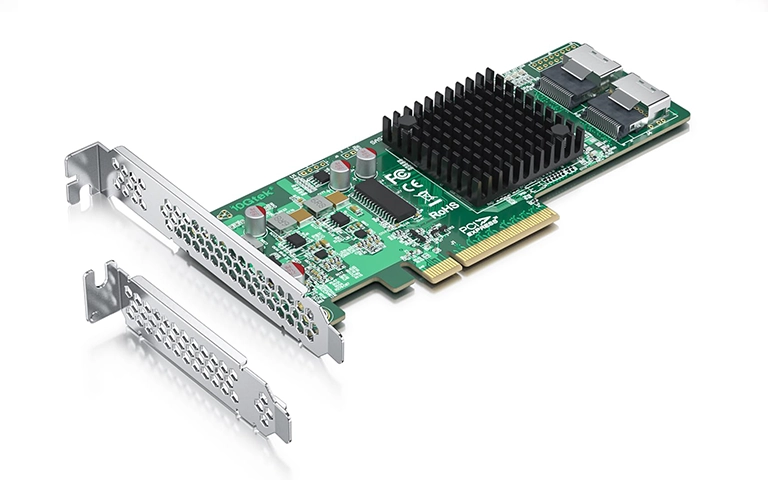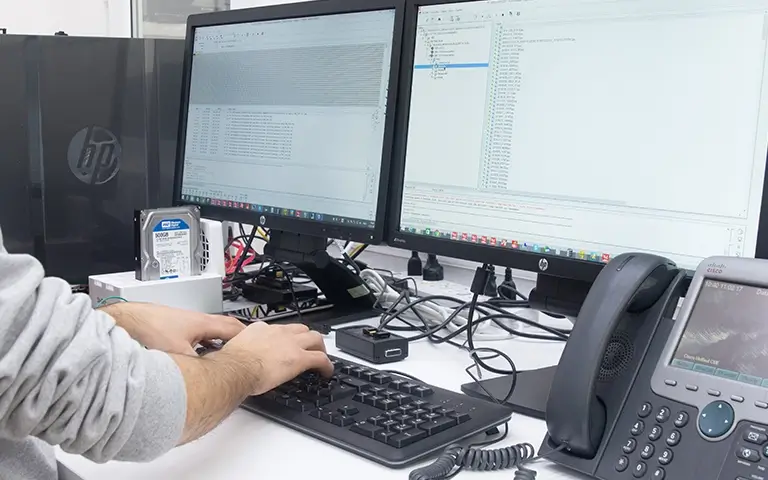When storage systems run at sustained high loads, even dependable platforms like LaCie NAS can fail.
Our engineers recently handled a two-disk LaCie NAS in RAID 0 that became unresponsive after prolonged heavy use. The customer selected RAID 0 for performance, but once the unit failed, the entire dataset was inaccessible.
Recognising the urgency, the client engaged RAID Recovery Services. What began as an overload issue quickly escalated into a complex recovery involving both hardware faults and a damaged RAID controller.

Device Configuration and Failure Symptoms
The affected unit was a LaCie NAS with two 2 TB Seagate Barracuda hard drives configured as RAID 0. The client chose this for higher read and write throughput.
RAID 0 provides no redundancy. If a single disk fails, the entire dataset becomes inaccessible.
After extended operation under heavy workload, the system showed intermittent slowdowns. The RAID volume then disappeared from the operating system, and file access failed outright. A manual reboot was attempted, but the NAS was not detected on the network.
For a deeper look at how RAID 0 compares to alternative setups, see our guide on RAID 0 vs RAID 1.
Expedited evaluation and diagnostic findings
After speaking with our support team, the client opted for our expedited evaluation service, which delivers a full diagnostic report within eight hours. The device was securely packaged and shipped to our data recovery laboratory.
On arrival, our engineers carried out a detailed inspection in a controlled cleanroom environment. Key findings:
Drive status: One disk was fully operational. The second exhibited severe PCB malfunction.
RAID controller: Controller data was corrupted, preventing the system from detecting the array.
Array condition: The RAID 0 set could not be rebuilt automatically due to missing controller metadata and the absence of parity.
These results confirmed that a combination of hardware damage and configuration corruption led to the outage. For similar diagnostic insight, explore our post on RAID hard drive failure.

RAID 0 recovery process
Once the client approved the work, our engineering team executed a staged recovery designed to preserve data integrity at every step.
The healthy disk was imaged in full, and a partial clone of the failed disk was created using dedicated hardware to capture the maximum number of readable sectors.
The damaged PCB was repaired on a temporary basis to enable short operational windows. This allowed extraction of the critical sectors required to rebuild the array.
Using recovered metadata and array logs, our engineers manually rebuilt the RAID 0 set, confirming stripe size, offset, and disk order to mirror the original configuration.
Corrupted controller parameters were reconstructed, restoring access to the logical volume and validating the full file and folder structure.
For a practical overview of spotting and resolving complex array problems, review our guide on Troubleshoot RAID Failure.

Data Verification and Result
After rebuilding the array, our engineers verified the recovery by running checksum comparisons and validating file integrity across both disk images. All user folders, documents, and project files were fully restored.
The client then joined a remote verification session to confirm accessibility and accuracy. Once approved, the data was copied to a new external drive and securely dispatched to the customer.
Fast turnaround times for business-critical data
Key Takeaways from the Case
This LaCie NAS recovery underscores several operational lessons for teams running high-performance storage.
RAID 0 has no fault tolerance. If one disk fails, the entire dataset is lost.
Sustained workload raises risk. Continuous heavy use increases heat and electrical stress, leading to mechanical or PCB failures.
Proactive monitoring avoids crises. Early symptoms such as slowdowns or missing volumes should trigger immediate investigation and backups.
Professional evaluation matters. Attempting DIY rebuilds or repairs without the right tools can destroy recoverable data.
Learn more about common failure scenarios in our post on NAS Data Loss Causes.

Professional Help for NAS Failures
Recovering data from a failed NAS requires specialist skills and controlled lab conditions. In this case, careful handling and precise parameter reconstruction enabled a complete recovery. Attempting fixes without professional tooling could have led to permanent loss.
If your LaCie NAS or any other RAID system has failed or stopped responding, engage RAID Recovery Services. Our specialists work across all RAID levels and NAS brands to deliver fast, secure, and verified recoveries.
For further insight into restoring damaged arrays, read NAS Failure and Recovery.
Trust the experts with proven results
Frequently Asked Questions
What causes a LaCie NAS to fail under heavy workloads?
Sustained high data transfer and large file operations can raise temperatures, stress the disks, and strain the RAID controller. Over time this leads to read or write errors and, in severe cases, complete failure.
Can I rebuild a failed LaCie NAS RAID 0 at home?
No. RAID 0 has no redundancy, and incorrect rebuild attempts can overwrite critical sectors. Engage a specialist such as RAID Recovery Services to reconstruct parameters safely.
How long does a professional NAS evaluation take?
Our expedited evaluation provides a full diagnostic report within 8 hours of receipt. Standard evaluations typically take 1 to 2 business days depending on drive condition.
Is data recovery possible if one drive in a RAID 0 array fails?
Often yes, provided the damaged disk can be imaged at least partially. Engineers can combine the good disk image with readable sectors from the failed one to rebuild the array.
How can I prevent NAS failures caused by overloading?
Monitor SMART health, maintain adequate cooling and airflow, schedule intensive tasks, and back up regularly. Choose a redundant RAID level such as RAID 5 or RAID 6 to reduce risk.